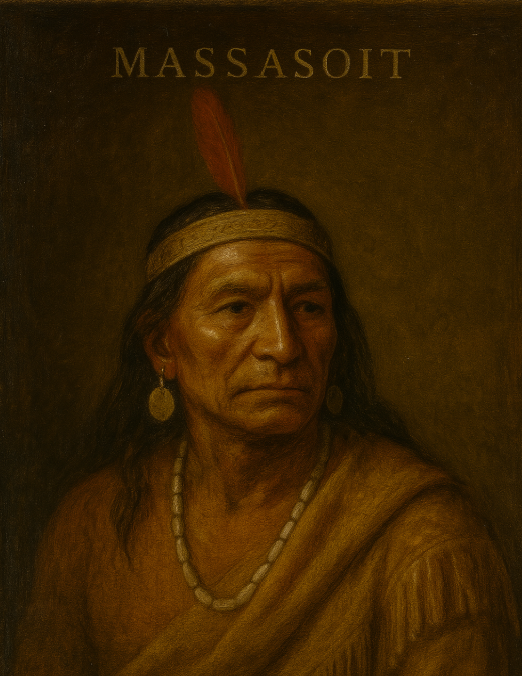
Massasoit, Sachem who possibly betrayed the author's ancestors, allowing the "Pilgrims" of Plymouth Colony to attack first. Image is AI-generated
In 1623 a second group of settlers arrived in Plymouth, Massachusetts. This group is sometimes referred to as the “Rude Fellows.” Upon their arrival at the colony, their dishonesty, laziness, and stealing of food made their stay at Plymouth very contentious. After exhausting the welcome extended to them by the pilgrims, members of the colony were happy to see them leave, when the new arrivals discovered land that was suitable for a new settlement to the north of the original colony. The new settlement was named Wessagusset and was located in the Massachusett Tribal Nation’s territory.
As time passed, Massasoit, the arbitrator of peace among the Native population and the pilgrims, began having internal trouble with the other sub-Sachems within the tribal nation. The sub-sachems’ trust of the English began to wane. Not trusting his collaboration with the English, Massasoit began being threatened, and there was even a plot that was foiled by the pilgrim Myles Standish to kidnap him.
At Wessagusset, as time passed, the Rude Fellows began to suffer from starvation, and as the climate turned cold during the winter, they hadn’t prepared adequate housing, and they hadn’t planted food. In comparison to Plymouth, this group’s relations with their Native population was deplorable. The English stole from them, violated Native women, and harassed and chastised the Indians in the Massachusett tribe. Over time, it got so bad that the Massachusett had the new settlers acting as their servants.
Around this time, Myles Standish, the leader of Plymouth colonies’ defense, and Hobomock, Massasoit's trusted emissary, visited Sachem Canacum at his village. They were surprised to see that Witawamit, a warrior with the Massachusett tribe, was there. Upon seeing Standish, Witawamit gestured angrily at him and angrily spoke in Native dialect about him to Canacum. Standish discovered later that Witawamit had spoken about attacking him and Plymouth. Deciding to wait until a later date, Standish told Governor Bradford about this and wanted to pre-emptively strike. However, the governor thought that this went against the peace treaty.
The relations at Wessagusset got so strained that one of the settlers of the colony escaped and went to Plymouth to tell them of the dangerous situation with the Massachusett Indians. As time passed, Massasoit became ill. After hearing about this, the pilgrims sent a self-appointed ambassador named Edward Winslow, who visited Massasoit, gave him a remedy, and restored his health as well as others in the village.
Massasoit was so grateful that he rewarded Winslow by telling him of an imminent attack being planned on Wessagusset and Plymouth by the Massachusett and other tribes. At that time, it was decided action would be taken by Myles Standish and his militia. They would go to Wessagusset. To attack and eliminate this threat, a number of Massachusett were killed. My ancestor Sachem Canacum was killed, Sachem Iyannough of the Cummaquid tribe was killed, and Sachem Appanow of the Island Capoge/Capawock (now called Martha’s Vineyard) was killed.
This writer's questions are, after having his authority challenged, how long did Massasoit know about the war plans of the surrounding tribes? If Edward Winslow had not come to Massasoit's aid during his illness, would these plans have succeeded? Would Plymouth and Wessagusset have vanished like the first colony in Virginia in 1590?
